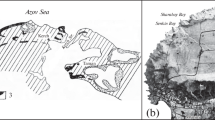Abstract
Modern ooids from the Cleopatra Beach on Island in the Gökova Bay, South Aegean Sea, resemble ooids formed on the Bahamian platform. The concentric coatings of the ooids consist of two or more laminae around a carbonate- or non-carbonate nucleus. The oolite cortex is transparent, whereas the non-transparent portions seem to be the dark fields on the oolitic surfaces. The ooids are mixed with molluscan skeletal debris displaying micritic envelopes. Weakly consolidated ooids have been cemented by calcite in the form of meniscus cement.
According to electron-microscope studies, three kinds of crystal shapes have been distinguished, as follows:
-
1-
Micronodules attributed to microboring organisms such as cyanobacteria or coccoids;
-
2-
Tablet-shaped crusts of hemispheres; likely produced by bacterial activity,
-
3-
Acicular- or elongate crystals precipitated directly from sea water in vacated holes of the microborings or as of the tangentially orientated parts of the ooids.
Algal- and bacterial processes are thought to have been main sources of the carbonate that was precipitated to form the ooids.
Similar content being viewed by others
References
BOQUET, E., BORONAT, A., and RAMOS-CORMENZANA, A., 1973, Production of calcite (calcium carbonate) crystals by soil bacteria is a general phenomenon:Nature, v. 246, p. 527–528.
BATHURST, R.G.C., 1966, Boring algae, micrite envelopes and lithification of molluscan biosparite:Geol. Journ., v. 5, p. 15–32.
BEALES, F.W., 1958. Ancient sediments of Bahaman type:Amer. Assoc. Petrol. Geologists Bull., v. 42, p. 1845–1880.
BUCZYNSKI, C., and CHAFETZ, H.S., 1990, Habit of bacterially induced precipitates of calcium carbonate and the influence of medium vicosity on mineralogy:Jour. Sedimentary Petrology, v. 61, p. 226–233.
ESELLER, G., 1990, Modern ooids from Sedir Island (Cleopatra Beach). S.Aegean Sea: International Earth Sciences Congress on Aegean Region, Izmir-Türkiye, Abstracts, p. 101–102.
FABRICIUS, F.H., 1977, Origin of marine ooids and grapestones:Contrib. Sed., v. 7, p. 113.
FREEMAN, T., 1962, Quiet water oolites from Laguna Madre, Texas:Jour. Sedimentary Petrology, v. 32, p. 475–483.
FRIEDMAN, G.M., AMIEL, A.J., BRAUN, MOSHE, and MILLER, D.C., 1973, Generation of carbonate particles and laminites in algal mats-example from sea-marginal hypersaline pool, Gulf of Aqaba, Red Sea:Am. Assoc. Petroleum Geologists, Bull., v. 57, p. 541–557
FRIEDMAN, G.M., GEBELIN, C.D., and SANDERS, J.E., 1971, Micrite envelopes of carbonate grain are not exclusively of photosynthetic algal origin:Sedimentology, v. 16, p. 89–96.
GARBER, R.A., FRIEDMAN, G.M., and NISSENBAUM, A., 1981, Concentric aragonitic ooids from the Dead Sea:Jour. Sedimentary Petrology, v. 51, p. 455–458.
GOLOBIC, S., BRENT, G., and LECAMPION, T., 1970, Scanning electron microscopy of endolithic algae and fungi using a multipurpose casting-embedding technique:Lethaia, v. 3, p. 203–209.
HARRIS, P.M., HALLEY, R.B., and LUKAS, K.J., 1979, Endolithic microborings and their preservation in Holocene-Pleistocene (Bahama-Florida) ooids:Geology, v. 7, p. 216–220.
KOBLUK, D.R., and RISK, M.J., 1977, Calcification of exposed filaments of endolithic algae, micrite envelope formation and sediment production:Jour. Sedimentary Petrology, v. 47, p. 517–528.
LALOU, C., 1957, Studies on bacterial precipitation of carbonates in sea water:Jour. Sedimentary Petrology, v. 27, p. 190–195.
MARGOLIS, S.; and REX, R.W., 1971, Endolithic algae and micrite envelope formation in Bahamian oolites as revealed by scanning electron microscopy:Geol. Soc. America Bull., v. 82, p. 843–852.
MAURIN, A.F.; and NOEL, D., 1977, A possible bacterial origin for Famennian micrites: in Flügel, E., ed., Fossil Algae, New York, Springer-Verlag, p. 136–142.
MAY, J.A.; and PERKINS, R.D., 1979, Endolithic infestation of carbonate substrates below the sediment-water interface:Jour. Sedimentary Petrology, v. 49, p. 357–378.
MITTERER, R.M., 1971, Comparative amino acid composition of calcified and non-calcified polychaete worm tubes:Comp. Biochem. Physiol. p. 38 B, 405–409.
NEWELL, N.D.; IMBRIE J.; and PURDY, E.G., 1960, Bahamian oolitic sand:Jour. Geol. v. 68, p. 481–497.
SUESS, E., and FUTTERER, D., 1972, Aragonitic ooids: Experimental precipitation from seawater in the presence of humic acid:Sedimentology, v. 19, p. 129–139.
Author information
Authors and Affiliations
Rights and permissions
About this article
Cite this article
Üsenmez, S., Varol, B., Friedman, G.M. et al. Modern ooids of Cleopatra Beach, Gokova (South Aegean Sea) Turkey: Results from petrographyand scanning electron microscopy. Carbonates Evaporites 8, 1–8 (1993). https://doi.org/10.1007/BF03175158
Received:
Accepted:
Published:
Issue Date:
DOI: https://doi.org/10.1007/BF03175158




